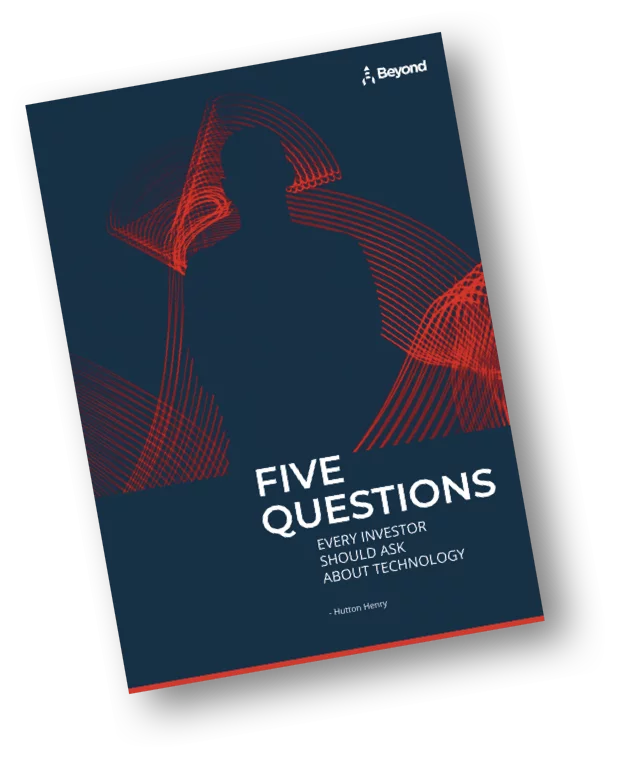What is value creation in technology?
“Value Creation” in business results from transformation and discipline. It is also the holy grail for due diligence and M&A advisors. As focusing on value creation means adapting from providing an audit to outlining a transformation.
But I find the term ‘value creation’ has such a wide scope – encompassing everything that can contribute to growth. Therefore it is difficult to visualise what it is in pragmatic terms. But if we reduce the scope to “value creation in technology”, I think it is easier.
We actively seek areas where customers can create additional, sustainable value when on a tech due diligence project.
Worldwide Tech spending has increased in recent years, from $3.8tn spent in 2020 to $4.8tn forecast in 2023, according to a recent Statista report.
But not all technology spending is the same. It takes talent and experience to deploy technology in meaningful ways.
Increasing value could include improving products, providing lower-cost services, or creating new markets. Today, these value-creation levers depend on technology in some way or form.
Finding red flags can help investors before a deal but identifying potential value creation fuels positive change and better solutions.
Value creation is not a case of ‘one and done’
It is imperative that the value creation plan is not discarded as soon as the deal completes. The value creation plan needs to be continually updated and accountability is necessary to track progress.
I advise tech leaders to treat every board meeting as a pitch. To not assume they will walk out with all necessary resources. They must put a strong argument for change and investment and clearly demonstrate the value they will create. Most importantly, this information needs to be concise, punchy and engaging.
There are several challenges that could impact your ability to focus on value-creation activities:
Lack of financial rigour
A lack of financial rigour is typical when we assess firms during technology due diligence. Leadership struggle to articulate the value technology can bring.
The problem is much of this technology spend is wasted. Poor discipline and planning are evident in most of the assessments we undertake. Teams struggle to align financial spending and day-to-day activity.
According to Venturebeat enterprises, on average, $4.12 million per organisation is wasted on failed, delayed or scaled-back initiatives. Adding that 80% of the leaders surveyed had projects fail, suffer delays or be scaled back.
The cloud is more expensive and complicated
Firms are also overspending on cloud technology, and spending in the cloud ramps up fast.
According to a Couchbase survey of 650 Tech Leaders, enterprise firms are overspending by more than $8.75m on cloud services. More than one-third (36%) of enterprises said cloud services adopted in the last three years had not met expectations. Meanwhile, 56% said past cloud decisions had made digital transformation projects more difficult in 2021 and 48% more expensive.
It is essential to consider both SaaS (e.g. a CRM platform) and in-house bespoke products (e.g. in-house SaaS). Both types of software need careful inspection.
We often spot overspending through analysis of the IT budget. And the teams may not be aware they are wasting money while chasing new functionality.
This may be due to the team not fully understanding what they are doing, or when vendors oversell what’s needed.
IT teams can often run bloated, expensive cloud systems for years. Bringing in speiclaist skills on a temporary basis can address this problem.
Lastly, cloud systems can often be purchased by staff outside of IT, a.k.a. ‘Shadow IT”. Hence, there can be excess spending and controls.
Poor adoption of new technology
There is often resistance to change and the adoption of new technology. Hence, firms waste money on expensive software which isn’t used properly. Ensuring proper adoption and use by staff should ensure better value from your investment.
If we look at CRMs as a classic example. You have probably worked in a firm that does not use its CRM fully. For example, 40-50% of salespeople still resist CRM software. In addition, consulting firm ZSA wrote that 72% of sales leaders don’t believe their people spend enough time in CRM.
I understand, as I am that salesperson. I find CRM software cumbersome and slow to use. You need to manually enter too much information and tell it what to ‘do’. Often teams will revert to Spreadsheets until good processes and rigour are added.
The issue is not with the technology. We do not spend enough time systemizing, teaching and learning new technology. I think technology adoption is poor as employees expect our workplace technology to be as intuitive and straightforward as Spotify. But Spotify only has one primary function. We must read the manual (or be trained) for business software to support something more complex.
Poor adoption of systems is a known concern. The leading vendors understand this challenge and publish tools like Microsoft 365 Adoption tools. These tools are detailed guides on how to engage, train and build ‘cloud champions’ within firms.
I worked for a Global Retailer where the Technology Team had spent a few million on a shiny new system. However, when I visited the shop floor, I learned management had told the staff not to use the system. IT was sitting in an ivory tower, naively proud of its achievements whilst its efforts were going to waste.
Simply put, a lack of adoption by users is a significant hidden cost that needs addressing.
The Good News
If your firm has or will be working with an institutional investor, you will need to sharpen up your strategy, spending, forecasting and adoption of technology.
No more ‘organic’ decisions. You will need to develop laser vision and build value in areas that provide a return on investment.
Simplification and data are critical. You will need to be able to justify your spending on your team, ventures and technology regularly.
Think of it as guardrails to help you make the most of your efforts and spending. To increase your financial performance.
Sharpening your perspective on tech spend and planning will typically increase the value of tech in your firm.
Value Creation in Tech
Post-deal, there is pressure to show you can master the essentials. It’s important to spend time planning change and not to rush, investing in expensive technology without mapping out how you intend to create value.
Value Creation Levers
The strategy to better value is simple, but you need to look at the business to determine the bottlenecks. You need to be able to answer the following question clearly:
What areas can you use technology to create efficiencies?
Do more with what you have today
Making better use of the resources and technology you have today is common sense. Yet we often meet technology and business leaders aware of cost efficiencies but have deprioritised them.
There are no generic solutions to create value, so here are some examples:
- Pre-pandemic. A portfolio firm used new technology to move 600 of its staff to WFH, allowing the firm to drastically reduce rent. This initiative was controversial at the time because it was proposed before the pandemic. The CEO faced significant pushback from the investors and board. As they assumed people could not be trusted to work from home. In hindsight, this was pioneering and on-trend.
- Data is a significant asset within firms that is not utilised enough. Poor data visibility is often the cause of poor financial performance. The best teams we assess use technology and data to drive marketing, pricing and sales.
- Automation can reduce client responses; bots can be used to answer basic questions. Neither of these ideas is a ground-breaking or expensive solution. But it takes a collaboration between customer support and the technology function to devise something useful.
One of the best areas to invest in is in your employees. Helping the right people learn new skills and exposing them to different business areas sparks creativity.
Many firms we’ve met in the past 12 months have decided to train their staff on Artificial Intelligence. This has the added benefits of increased staff engagement and reutilising their current knowledge of the firm.
Reduce spending.
As pointed out above, reducing cloud spending should be the top of the agenda. The FinOps Foundation define Cloud Finops as follows:
“FinOps is an evolving cloud financial management discipline and cultural practice that enables organizations to get maximum business value by helping engineering, finance, technology and business teams to collaborate on data-driven spending decisions.”
The FinOps Foundation also provides an excellent guide to developing a FinOps Strategy and Roadmap.
Outside of the cloud, many other spending areas can be reduced. Hopefully, these have been identified during technology due diligence (hint, hint).
Rationalise
I’ve separated ‘rationalise’ from ‘reduce’ spending as it is a specific way of reducing spending. Rationalisation within a portfolio firm could be many things. Such as moving all back-office functions to a shared service or merging firms if they were acquired through M&A.
From a systems perspective, rationalisation can be reducing services or co-locating them. It can be adapting software or migrating all employees to the same solution.
The challenge here is not in the complexity of the rationalisation but in the reluctance to change. Typically these projects are not very interesting and can create political differences as people’s preferences kick in. So they are challenging projects to manage, often low profile, and no one wants to be on them.
They are the digital equivalent of ‘austerity’.
On the plus side, the results can be fantastic. In one project, the company was made up of multiple acquisitions. We spent £2.1m removing 900 servers which reduced the licenses, upkeep and maintenance of all. It delivered 3x ROI over the long term and provided some better green credentials!
Improve user productivity and increase adoption
Focusing on ease of use can improve employee productivity. But said improvements could take investment.
Some firms have sweated their digital platforms with minimal investment before the transaction. Hence they can be old or cumbersome to use. In some of the worst cases, a re-platform may be required. For example, in a recent Technology Due Diligence, we identified approx. £5m was needed to modernise a platform.
That is not exactly what the exiting MD wanted to hear. But it was essential to modernise to ensure the firm could remain relevant. Technology became a high-profile agenda. Leadership needed to set the vision, develop plans and hire new staff to begin the transformation. A year on, it’s still a high-profile concern.
Plus, for buy-and-build situations, some firms ‘smash’ the firms and systems together, providing a terrible end-user experience. People copy-pasting from one screen to another due to a lack of integration. It’s often easier to let people work this out manually than spend the time & money to address it.
The problem is this creates a negative user experience. We have seen staff complain about these scenarios on GlassDoor – software being so poor it impacts a firm’s reputation.
How can technology fuel the value creation plan?
Our CTOs tend to work with portfolio firms to help them make the best of the technology invest. Typically we can help with strategic planning, technology assessments and roadmap development. Following this, customers engage with us for external accountability.
Sitting between the investor and the portfolio, we can work as the ‘translator’ and highlight issues before they escalate. Supporting technology leadership, we help teams and increase the accountability in areas such as:
- Align investment thesis and growth plans with activity in the tech function
- Identify skills gaps and cost-effective ways to address it.
- Improve commercial reporting
- Add significantly more discipline and rigour to SaaS product development
- Cloud cost optimisation opportunities.
- Identifying tech-led value creation opportunities during due diligence and before a deal completes.
- Cross-pollinate experience – re-using solutions to make firms more productive.
- Identify what data assets can be used more effectively.
Don’t do this alone.
Value creation is an ongoing process, not a single event or presentation to support the sale or investment.
There are many angles to increase value from technology. You don’t need to do everything and don’t necessarily need to spend a lot to make an impact. The best solution will always be when the functional business units and technology functions collaborate with the same goals. Which is easier to write than execute.
At Beyond, we find it far more rewarding and tangible to help firms implement their value-creation plans. We recommend routine analysis of the value delivered by tech solutions against spending. This means developing a clear value creation model. Followed by regular checkpoints and assessment of the roadmap and budget with key business stakeholders.





